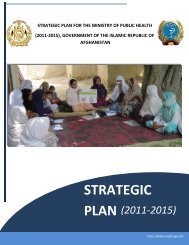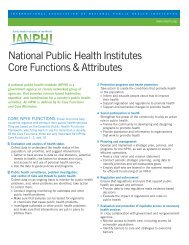ethiopian health and nutrition research institute - ianphi
ethiopian health and nutrition research institute - ianphi
ethiopian health and nutrition research institute - ianphi
- No tags were found...
You also want an ePaper? Increase the reach of your titles
YUMPU automatically turns print PDFs into web optimized ePapers that Google loves.
6.2 Strategic Themes (Pillars) <strong>and</strong> Strategic ResultsThe strategic themes also referred to as ‘pillars of excellence,’ build the foundation of the<strong>institute</strong>. EHNRI must excel in the four pillars listed below in order to meet its vision, mission<strong>and</strong> the expectation of its internal <strong>and</strong> external customers. A strategic result was formulatedfor each pillar of excellence.EHNRI’s Four Pillars of Excellence are:A. Excellence in Research <strong>and</strong> Technology TransferB. Excellence in Public Health Emergency ManagementC. Excellence in Public Health Laboratory QualityD. Excellence in Management <strong>and</strong> Leadership6.2.1 Pillar I. Excellence in Research <strong>and</strong> Technology TransferEvidence based information about the public <strong>health</strong> in Ethiopia is severely lacking. Problemsolving <strong>research</strong> that is aligned with priority areas <strong>and</strong> that satisfies ethical st<strong>and</strong>ards isneeded to generate high quality scientific information. At present, national data on diseaseburden, distribution, type, <strong>and</strong> transmission dynamics of various infectious diseases arelimited. Knowledge about the prevalence of non-infectious diseases <strong>and</strong> environmental riskfactors, as well as occupational hazards is extremely limited. Few reports have been writtendescribing antimicrobial resistance levels of various drugs used against infectious diseases, aswell as limited reports about insecticides used to control disease vectors. Clinical trials areneeded to improve existing preventive measures <strong>and</strong> to validate available diagnostictechniques. The impact of disease reduction, elimination <strong>and</strong>/or eradication strategies shouldbe assessed <strong>and</strong> an evaluation of immunization programs for vaccine preventable diseases<strong>and</strong> other interventions should be conducted. Furthermore, an investigation of genetic <strong>and</strong>immunologic features of human-pathogen interactions would help scientists to underst<strong>and</strong>disease initiation, progression or protection in light of current scientific <strong>and</strong> technologicaldevelopments that provide powerful tools to generate valuable information for diseasecontrol efforts.24




